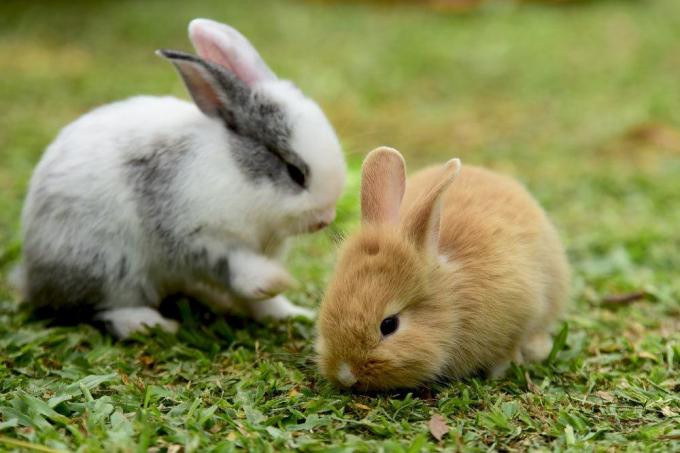
table of contents
- Toxicity
- Effect on animals
- Cats
- dogs
- Rodents and rabbits
- Farm animals
Kalanchoe blossfeldiana, better known as Flaming Kathchen, is one of the most popular ornamental plants in Germany and provides appealing splashes of color in the home even through the winter thanks to its permanent bloom. The succulent is often kept as a houseplant by humans or planted outdoors over the summer. Due to the popularity of the plant, more and more owners are asking whether the Flaming Käthchen is a poisonous plant.
Toxicity
Is Kalanchoe blossfeldiana poisonous? This question can be answered with a no and a yes, because the plant is non-toxic for humans, but toxic to highly toxic for animals. It is true that children and sensitive people can have mild symptoms in the range of gastrointestinal complaints such as vomiting or diarrhea, but only if extremely high amounts of the plant have been consumed. Animals are at great risk because of the cardiac glycosides they contain, a group of active substances that can work in different ways:
- lower the heart rate
- increase the heart rate
- has a negative effect on the central nervous system
- increases the sodium concentration
- more calcium stays in the cells

A flaming cat does not contain enough cardiac glycosides to poison humans, but there are many other plants with these active ingredients. Some of these are highly toxic and consumption can be fatal:
- Red thimble (bot. Digitalis purpurea)
- Lily of the valley (bot. Convallaria majalis)
- White squill (bot. Drimia maritima)
As you can see, cardiac glycosides are not to be trifled with. Because of this, mild symptoms are noticeable when humans consume large amounts of the plant. However, the leaves and flowers don't taste really interesting and are therefore quickly spat out again. After consumption, it is sufficient for the affected person to drink plenty of water and consume some activated charcoal. You don't have to worry about maintenance because the glycosides do not get into the body through the skin.
tip: Another advantage of the Kalanchoe is the fact that the toxins are not increased in the sun or by heat, as is the case with plants such as the giant hogweed (. Heracleum mantegazzianum) is the case.
Effect on animals
Cats
If you have a cat as a pet, you should place a Flaming Katy as out of reach as possible. Because of the cardiac glycosides it contains, which act as a steroid in cats, the plant can cause numerous symptoms. As soon as the following symptoms appear, you should definitely contact the veterinarian:
- Irritation of the stomach
- Vomit
- diarrhea
- Paralysis
- Convulsions
- Shortness of breath
If the amount of plant parts eaten is unknown, the house tiger can even die. Since a cat has only weak, natural instincts in comparison to wild species such as tigers or a lynx, they do not recognize poisonous plants. Because of this, they nibble on almost every plant in the area to play with or to gain new experiences. Succulents are particularly popular. However, the toxicity of the plant is too high for cats and should therefore be banned from the household or placed in such a way that it cannot be chewed. This also applies to specimens that have been planted out in summer.

tip: The Kalanchoe is just as poisonous on birds as it is on cats. Small birds in particular can ingest a lethal dose from the smallest amount.
dogs
A Flaming Katy has a right to the dog little effect, however, it is not safe. The most important factors here are the amount eaten and the size of the animal. For example, if the dog is a Chihuahua or a Dachshund, a significantly lower amount is toxic to the animals. In most cases, dogs are not interested in the plant, unless they are puppies who, as a precaution, should not get to the plant. An immediate visit to the vet is not necessary, but the animal should be observed. Possible symptoms can be:
- Vomit
- diarrhea
- increased salivation
Rodents and rabbits
Rodents and rabbits should also be kept away from the plant, as it is just as toxic to them as it is to cats. The lethal dose is also unknown, but because of the small size of guinea pigs, hamsters and rabbits, even small amounts can be quickly fatal. The symptoms are similar to those in cats. After consumption, you should definitely take the animal to the vet.
Farm animals
Farm animals such as cows, sheep or horses are particularly sensitive to the succulents. Pigs are not as affected by the toxicity of Kalanchoe blossfeldiana. It is known that the lethal dose to a calf is seven grams of flowers per kilogram of body weight. Since a Flaming Käthchen in Central Europe can only spend the summer in the garden, the risk of poisoning is very low. However, you should be careful if livestock have access to your garden as the plants are extremely poisonous to them.

Source: http://www.gizbonn.de/106.0.html
Note: Please note that this article does not in any way replace a visit to the doctor. There is no guarantee that medical statements are correct.
You will find detailed information on first aid in the event of poisoning and important information on poison control centers here.


